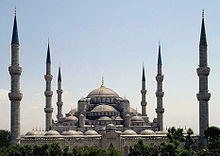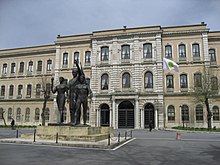Turkey - The 6th most popular tourism destination in the world
Would You Like to Travel to Turkey? Here is what we found out about this beautiful bride..

Republic of Turkey is a country with its smaller part in Southeastern Europe and its larger part in Western Asia. Turkey is surrounded by eight countries: Bulgaria to the northwest; Greece to the west; Georgia to the northeast; Armenia, Iran and the Azerbaijani exclave of Nakhchivan to the east and Iraq and Syria to the southeast.
The Mediterranean Sea is to the south; the Aegean Sea to the west and the Black Sea to the north. The Sea of Marmara, the Bosphorus and the Dardanelles (which together form the Turkish Straits) demarcate the boundary between Thrace and Anatolia; they also separate Europe and Asia.
Turkey's location at the crossroads of Europe and Asia makes it a country of significant geo-strategic importance.
Turkey is a democratic, secular, unitary, constitutional republic with a diverse cultural heritage.
The country's official language is Turkish, a Turkic language spoken natively by approximately 85% of the population. About three quarters of the population are ethnic Turks and about a fifth ethnic Kurds.
The vast majority of the population is Muslim. Turkey is a member of the UN, NATO, OECD, OSCE, OIC and the G-20. After becoming one of the first members of the Council of Europe in 1949, Turkey became an associate member of the EEC in 1963, joined the EU Customs Union in 1995 and started full membership negotiations with the European Union in 2005.[24] Turkey's growing economy and diplomatic initiatives have led to its recognition as a regional power.
Tourism

Tourism in Turkey
has experienced rapid growth in the last twenty years and constitutes
an important part of the economy.
In 2013, 37.8 million foreign visitors
arrived in Turkey, which ranked as the 6th most popular tourism destination in the world; tourism contributed $27.9 billion to Turkey's revenues.
In 2012, 15% of the tourists were from Germany, 11% from Russia, 8% from the United Kingdom, 5% from Bulgaria, 4% each from Georgia, the Netherlands and Iran, 3% from France, 2% each from the USA and Syria, and 40% from other countries.
Turkey has 13 UNESCO World Heritage Sites, such as the "Historic Areas of Istanbul", the "Rock Sites of Cappadocia", the "Neolithic Site of Çatalhöyük", "Hattusa: the Hittite Capital", the "Archaeological Site of Troy", "Pergamon and its Multi-Layered Cultural Landscape", "Hierapolis – Pamukkale", and "Mount Nemrut"; and 51 World Heritage Sites in tentative list, such as the archaeological sites or historic urban centers of Göbekli Tepe, Gordion, Ephesus, Aphrodisias, Perga, Lycia, Sagalassos, Aizanoi, Zeugma, Ani, Harran, Mardin, Konya and Alanya.
Infrastructure
Main articles: Transport in Turkey, Communications in Turkey and Energy in Turkey
Istanbul Ataturk Airport is the 14th busiest airport in the world with 17 million passengers.As of 2009, there were 102 airports in Turkey, including eight international airports. The new (third) international airport of Istanbul is planned to be the largest airport in the world, with a capacity to serve 150 million passengers per annum. Turkish Airlines, flag carrier of Turkey since 1933, was selected by Skytrax as Europe's best airline for three consecutive years in 2011, 2012 and 2013.
As of 2014, the country has a roadway network of 65,623 kilometres (40,776 mi). The total length of the rail network was 10,991 km in 2008, including 2,133 km of electrified and 457 km of high-speed track.
The Turkish State Railways started building high-speed rail lines in 2003. The Ankara-Konya line became operational in 2011 while the Ankara-Istanbul line entered service in 2014.
In 2008, 7,555 kilometres (4,694 mi) of natural gas pipelines and 3,636 kilometres (2,259 mi) of petroleum pipelines spanned the country's territory. The Baku-Tbilisi-Ceyhan pipeline, the second longest oil pipeline in the world, was inaugurated on May 10, 2005.
Demographics
| Historical populations | ||
|---|---|---|
| Year | Pop. | ±% p.a. |
| 1927 | 13,554,000 | — |
| 1930 | 14,440,000 | +2.13% |
| 1940 | 17,728,000 | +2.07% |
| 1950 | 20,807,000 | +1.61% |
| 1960 | 27,506,000 | +2.83% |
| 1970 | 35,321,000 | +2.53% |
| 1980 | 44,439,000 | +2.32% |
| 1990 | 55,120,000 | +2.18% |
| 2000 | 64,252,000 | +1.54% |
| 2010 | 73,003,000 | +1.29% |
| 2012 | 75,627,000 | +1.78% |
| Source: Turkstat | ||
According to the 2011 estimate, the population is increasing by 1.35% each year. Turkey has an average population density of 97 people per km². People within the 15–64 age group constitute 67.4% of the total population; the 0–14 age group corresponds to 25.3%; while senior citizens aged 65 years or older make up 7.3%. In 1927, when the first official census was recorded in the Republic of Turkey, the population was 13.6 million.
Istanbul which is the capital of Turkey is the third-largest city in Europe in terms of size.
Religion
Turkey is a secular state with no official state religion; the Turkish Constitution provides for freedom of religion and conscience. The role of religion has been a controversial debate over the years since the formation of Islamist parties. For many decades, the wearing of the hijab was banned in schools and government buildings because it was viewed as a symbol of political Islam.However, the ban was lifted from universities in 2011, from government buildings in 2013, and from schools in 2014.
Islam is the dominant religion of Turkey with 99.8% of the population being registered as Muslim.while some sources give a little lower estimate of 96.4%, with the most popular sect being the Hanafite school of Sunni Islam. The highest Islamic religious authority is the Presidency of Religious Affairs (Turkish: Diyanet İşleri Başkanlığı), it interprets the Hanafi school of law, and is responsible for regulating the operation of the country's 80,000 registered mosques and employing local and provincial imams. Academics suggest the Alevi population may be from 15 to 20 million and according to Aksiyon magazine, the number of Shiite Twelvers (excluding Alevis) is 3 million (4.2%).There are also some Sufi Muslims. Roughly 2% are non-denominational Muslims.
The percentage of non-Muslims in Turkey fell from 19% in 1914 to 2.5% in 1927.There are about 120,000 people of different Christian denominations, representing less than 0.2% of Turkey's population, including an estimated 80,000 Oriental Orthodox, 35,000 Roman Catholics, 5,000 Greek Orthodox and smaller numbers of Protestants. Today there are 236 churches open for worship in Turkey. The Eastern Orthodox Church has been headquartered in Istanbul since the 4th century.
There are about 26,000 people who are Jewish, the vast majority of whom are Sephardi. There have been Jewish communities in Asia Minor since at least the 5th century BCE and many Spanish and Portuguese Jews expelled from Spain were welcomed into the Ottoman Empire (including regions part of modern Turkey) in the late 15th century (see History of the Jews in the Ottoman Empire), twenty centuries later. Despite emigration during the 20th century, modern-day Turkey continues to have a small Jewish population.
Education
The Ministry of National Education is responsible for pre-tertiary education. This is compulsory and lasts twelve years: four years each of primary school, middle school and high school Less than half of 25-34 year old Turks have completed at least upper secondary education, compared with an OECD average of over 80%. Basic education in Turkey is considered to lag behind other OECD countries, with significant differences between high and low performers. Turkey is ranked 32nd out of 34 in the OECD's PISA study.Access to high-quality school heavily depends on the performance in the secondary school entrance exams, to the point that some students begin taking private tutoring classes when they are 10 years old. The overall adult literacy rate in 2011 was 94.1%, 97.9% for males and 90.3% for females.
By 2011, there were 166 universities in Turkey. Entry to higher education depends on the Student Selection Examination (ÖSS). In 2008, the quota of admitted students was 600,000, compared to 1,700,000 who took the ÖSS exam in 2007. Except for the Open Education Faculty (Turkish: Açıköğretim Fakültesi) at Anadolu University, entrance is regulated by the national ÖSS examination, after which high school graduates are assigned to universities according to their performance. According to the 2012–2013 Times Higher Education World University Rankings, the top university in Turkey is Middle East Technical University (in the 201-225 rank range), followed by Bilkent University and Koç University (both in the 226-250 range), Istanbul Technical University and Boğaziçi University (in the 276-300 bracket).
Source:
http://en.wikipedia.org/Tourism









No comments
Post a Comment